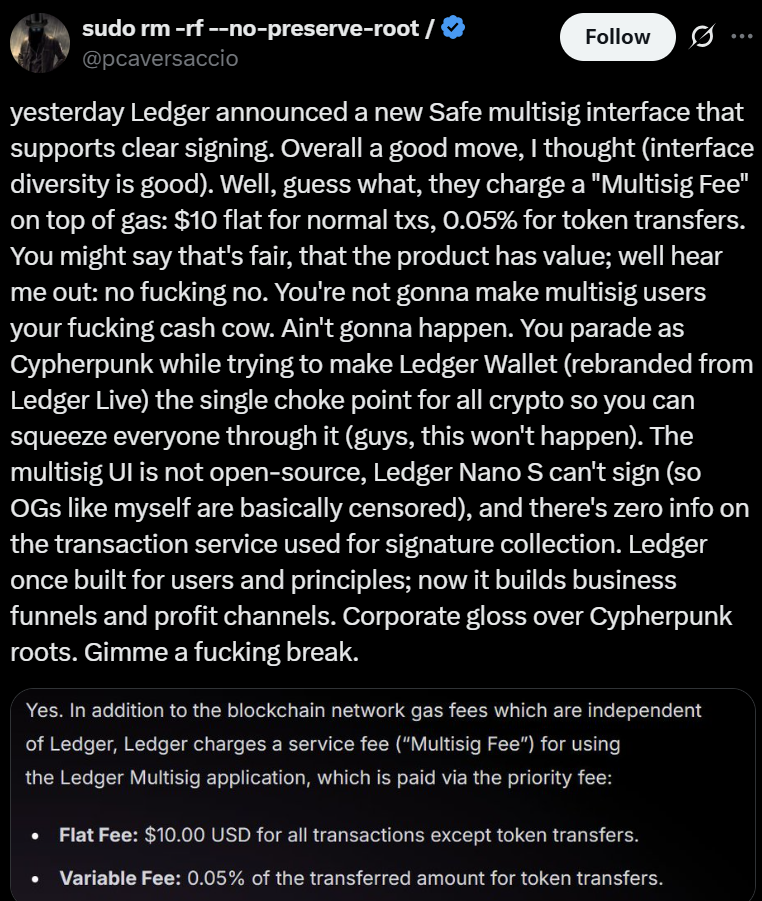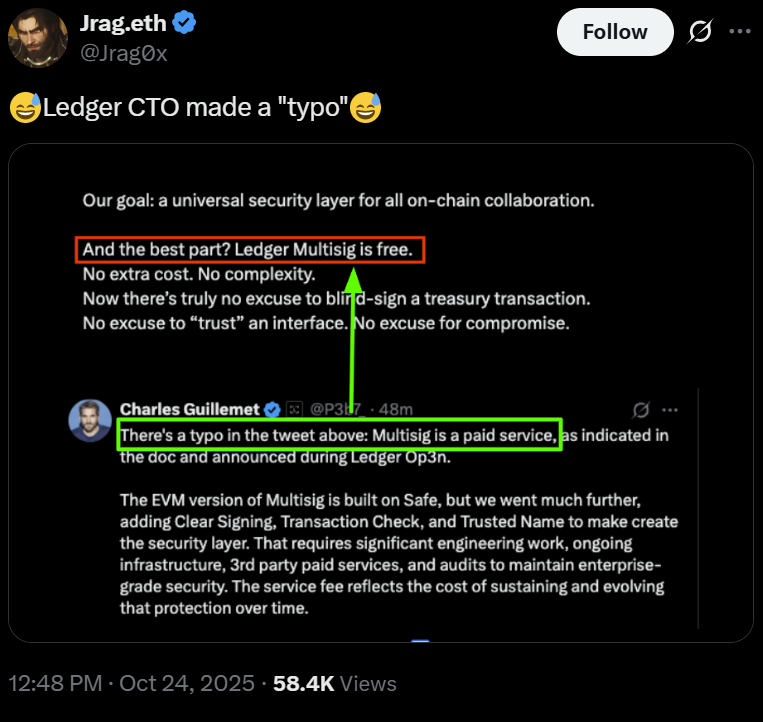Ledger’s new Multisig App enhances security for cryptocurrency users through advanced multi-signature transactions, but it introduces a $10 flat fee per transaction and 0.05% for token transfers, drawing criticism from developers over added costs on top of network fees.
-
Ledger’s Multisig App allows multiple keys for transaction approval, improving protection against unauthorized access.
-
The app’s fee structure includes a flat $10 for most actions and a variable 0.05% for token transfers, separate from blockchain gas fees.
-
Over 7.5 million Ledger devices sold secure about 20% of global crypto value, highlighting the company’s market dominance amid ongoing security debates.
Ledger Multisig App offers tech upgrades for secure crypto transactions but faces backlash over new fees. Discover user reactions, security benefits, and fee details in this in-depth analysis. Stay informed on hardware wallet innovations.
What is Ledger’s Multisig App and How Does It Work?
Ledger’s Multisig App is a new interface designed for hardware wallet users to implement multi-signature security protocols, requiring approvals from multiple private keys before executing transactions. This setup enhances protection for digital assets by distributing control, reducing the risk of single-point failures in custody. Launched recently, the app integrates seamlessly with Ledger devices, supporting various blockchains while emphasizing user sovereignty in crypto management.
How Do the New Fees in Ledger’s Multisig App Affect Users?
The Ledger Multisig App introduces a fee structure that has sparked significant discussion among cryptocurrency enthusiasts. Users face a flat $10 charge for most transactions, excluding token transfers which carry a 0.05% variable fee based on the transaction value. These fees are levied by Ledger in addition to the standard blockchain network gas fees, which users must pay separately to validators or miners.
Ethereum developer pcaversaccio expressed strong reservations on X, stating, “You parade as Cypherpunk while trying to make Ledger Wallet the single choke point for all crypto so you can squeeze everyone through it.” This critique underscores concerns that the fees could centralize control and undermine the decentralized ethos of cryptocurrency.
Further scrutiny arose from apparent discrepancies in Ledger’s communications. CEO Charles Guillemet highlighted the importance of clear signing for secure transactions, yet the app’s paid model seems at odds with earlier suggestions of free access. Guillemet later attributed mentions of it being free to a typographical error in prior documentation, clarifying that multisig functionality requires these charges for maintenance and development.

Source: pcaversaccio
Security experts emphasize that while these fees fund improvements, users must weigh them against alternatives like open-source multisig tools. According to reports from cybersecurity firm Kaspersky, hardware wallets like Ledger’s remain robust against remote hacks, but fees could deter adoption among cost-sensitive users in the broader crypto ecosystem.
Frequently Asked Questions
What Are the Specific Fees for Ledger’s Multisig App?
Ledger’s Multisig App charges a $10 flat fee for all transactions except token transfers, which cost 0.05% of the transaction value. These are additional to blockchain gas fees and apply to Ledger’s interface services, ensuring the app’s ongoing support and security updates for users managing multi-signature setups.
Is Ledger’s Multisig App Secure for Protecting Crypto Assets?
Yes, the Ledger Multisig App bolsters security by requiring multiple approvals for transactions, making it harder for attackers to compromise funds without accessing all keys. This aligns with best practices in self-custody, though users should still guard against phishing, as noted by security analysts at Kaspersky, to maintain overall protection of their digital assets.
Key Takeaways
- Enhanced Security Features: The Multisig App promotes multi-key approvals, safeguarding against single-key vulnerabilities in cryptocurrency transactions.
- Fee Structure Concerns: A $10 flat fee plus 0.05% for tokens adds costs beyond network fees, prompting debates on accessibility for everyday users.
- Market Leadership with Caveats: Ledger’s 7.5 million devices secure 20% of global crypto value, but transparency in pricing will be key to sustaining trust.
Ledger’s Market Reach and Security Record
Ledger stands as a dominant force in the hardware wallet sector, with over 7.5 million devices sold since its inception a decade ago. The company asserts that its products protect approximately 20% of the total value in the global cryptocurrency market, underscoring its pivotal role in enabling self-custody for users worldwide.
At its core, Ledger’s technology empowers individuals to retain full control over their private keys, aligning with the foundational principles of blockchain and decentralized finance. Unlike centralized exchanges, where assets are held by third parties, hardware wallets store sensitive information offline, minimizing exposure to internet-based threats.
Despite this strong security posture, challenges persist. Ledger reports no successful breaches of its devices in operational use, a testament to rigorous engineering standards. However, cybersecurity experts at Kaspersky highlight that human factors remain a vulnerability; phishing attacks and social engineering scams continue to target users, tricking them into divulging recovery phrases or seed words that could render even the most secure hardware ineffective.

Source: Jrag0x
The introduction of the Multisig App represents an evolution in Ledger’s offerings, aiming to address more complex security needs for institutional and high-net-worth users. By facilitating multi-signature setups, it allows for shared custody scenarios, such as in team-managed wallets or estate planning, without compromising the offline integrity of keys.
Industry observers note that while the technical advancements are commendable, the fee model could influence user adoption rates. In a market where free alternatives exist for basic multisig implementations on platforms like Bitcoin or Ethereum, Ledger’s approach positions it as a premium service provider. This strategy mirrors broader trends in crypto infrastructure, where enhanced usability often comes with monetization layers.
Looking at Ledger’s track record, the company has navigated past controversies, including a 2023 data breach that exposed customer emails, leading to subsequent phishing waves. Ledger responded by bolstering its recovery services and emphasizing education on seed phrase security. These experiences inform the current Multisig App’s design, which prioritizes clear transaction verification to prevent blind signing errors—a common vector for exploits.
From an E-E-A-T perspective, Ledger’s decade-long expertise in hardware security, combined with collaborations with blockchain protocols, establishes it as an authoritative player. Quotes from developers like pcaversaccio reflect the community’s vigilance, ensuring innovations like this app evolve with user feedback in mind.
Conclusion
Ledger’s Multisig App introduces robust multi-signature capabilities to its hardware wallet ecosystem, enhancing security for cryptocurrency transactions while addressing advanced custody needs. However, the accompanying fees—$10 flat plus 0.05% for tokens—have ignited debates on affordability and alignment with crypto’s decentralized ideals. As Ledger continues to secure 20% of global crypto value through its 7.5 million devices, transparent pricing and user-centric updates will be essential. For those prioritizing self-custody, exploring this app could fortify asset protection; monitor upcoming developments for potential adjustments that balance innovation with accessibility.
